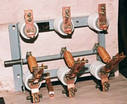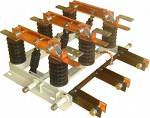Repair of disconnectors
Repair disconnectors consists of repair of insulators, conductive parts, actuator and frame.
First, remove dust and dirt from the insulators (slightly moistened with gasoline rag) and carefully examine them to identify defects and eliminate them. Then they check:
— fastening of movable and fixed contacts of the disconnector on insulators, as well as conductive sleeves,
— without displacement of the movable contact when switching on the disconnector relative to the fixed axis. If the displacement causes a shock moving contact for a fixed one, it is eliminated by changing the position of the fixed contact,
— contact reliability at the junction of tires with fixed contacts of the disconnector (clamping bolts must be locked),
— the contact density between the moving and stationary contacts of the disconnector, using a probe with a thickness of 0.05 mm, which should pass to a depth of no more than 5 — 6 mm. The change in density is achieved by tightening coil springs on the movable contact of the disconnector.Contact density, however, it must be such that the retraction forces do not exceed 100 — 200 N for disconnectors RVO and RV for current up to 600 A,
 — simultaneous swing of knives with three-phase disconnector jaws. When touching at different times, the distance A should not exceed 3 mm Adjustment is achieved by changing the length of the wires or rods of the individual phases. The knife disconnector in the closed position must be located from the base of the fixed contact at a distance of not more than 5 mm,
— simultaneous swing of knives with three-phase disconnector jaws. When touching at different times, the distance A should not exceed 3 mm Adjustment is achieved by changing the length of the wires or rods of the individual phases. The knife disconnector in the closed position must be located from the base of the fixed contact at a distance of not more than 5 mm,
— the moment of closing the auxiliary contacts of the disconnector. During turn-on, the circuit of the auxiliary contacts of the disconnector must close when the knife approaches the sponge (the knives may not reach the sponge by 5 degrees), and in the case of turn-off, when the knife passes 75% of its full stroke. Adjustment is achieved by changing the rod length of the auxiliary contacts and turning the contact washers on the hex shaft,
— the integrity of the plates of the flexible connection of the shaft of the earthing blades with the frame of the disconnector, connection of the earthing bus to the disconnector. For reliability of the connection of the surface of the ground bus and the frame of the disconnectors around the bolt holes are cleaned to a shine, lubricated with a thin layer of petroleum jelly and connected with a bolt. To avoid corrosion around the joint, the bolt should be paint,
— the clarity of the mechanical blocking of the separating shaft and grounding blades of the disconnector. Rub parts of disconnectors and drive coated with antifreeze lubricant and, if necessary, wipe beforehand with a cloth soaked in gasoline and cleaned with sandpaper, then remove rust and stains.
 The contact point of the knife and the jaw of the disconnector is covered with a thin layer of non-freezing grease or petroleum jelly. Permanent contact surfaces are cleaned with a soft steel brush.
The contact point of the knife and the jaw of the disconnector is covered with a thin layer of non-freezing grease or petroleum jelly. Permanent contact surfaces are cleaned with a soft steel brush.
the repaired disconnector must pass tests.
